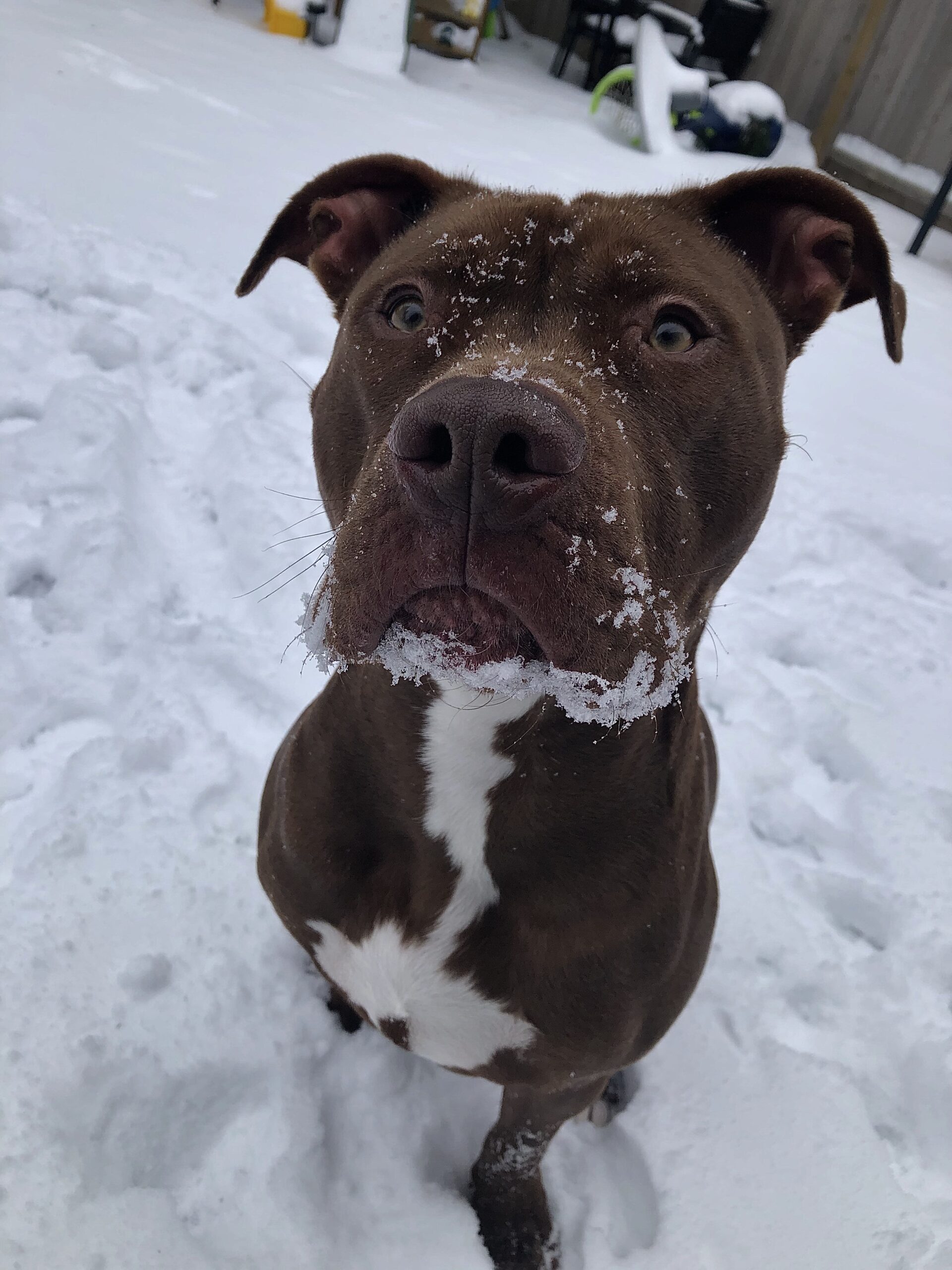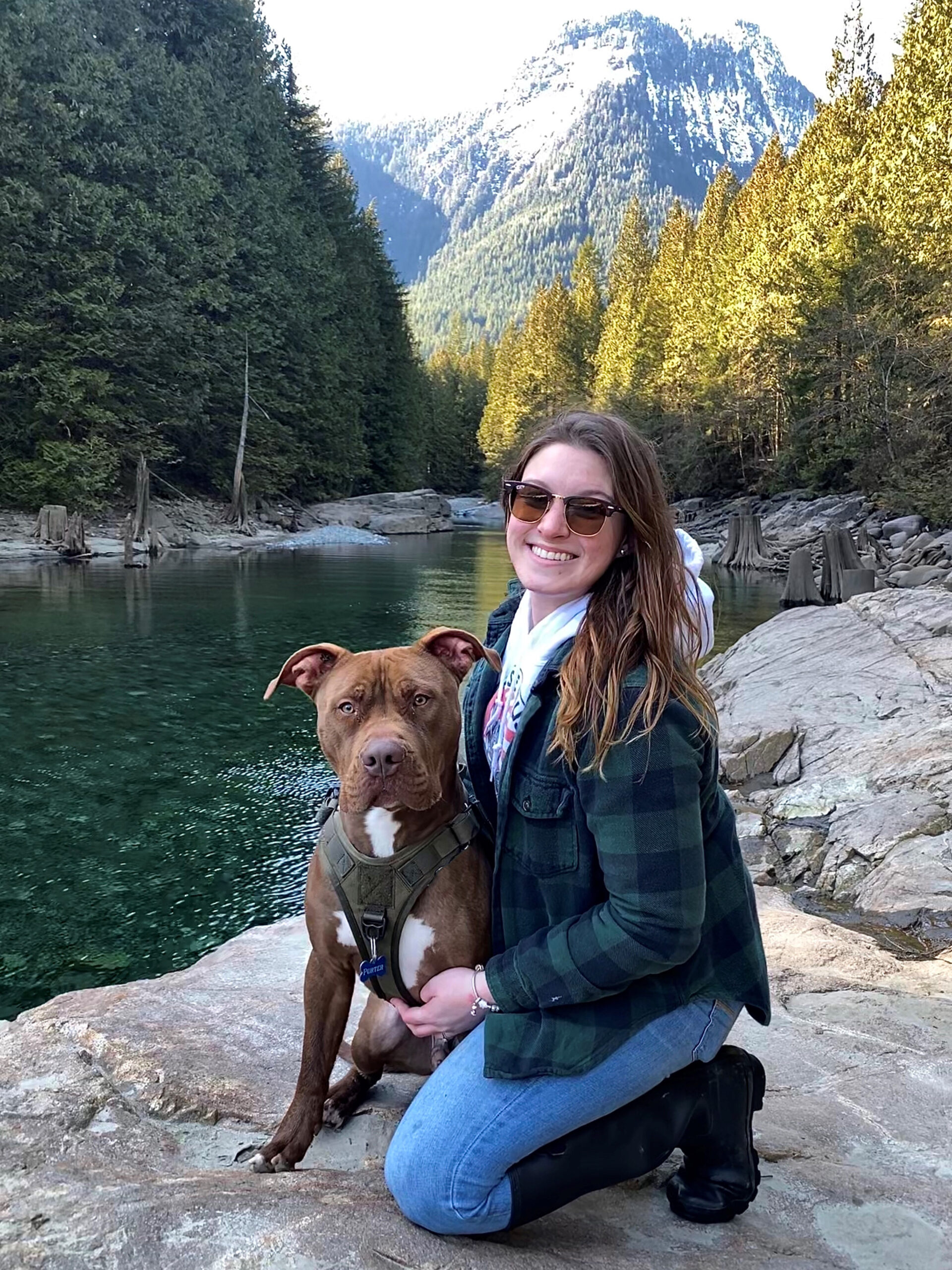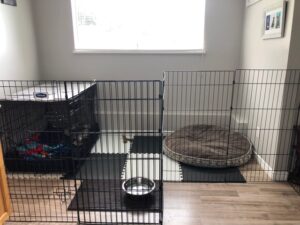Barks Blog
Puppy Joint Problems: An Unexpected Detour
By Gail Radtke

Porter came into Sam’s life at the age of 8 weeks old as a healthy, happy, and adorable American pit bull terrier pup.
Sam had met both Porter’s breeder and his biological mother and could not have been happier to bring Porter home and start raising her puppy.
Sam works as a veterinary assistant at an animal hospital in the Lower Mainland in British Columbia, Canada, and is well experienced in canine care.
Porter was your typical happy, playful, and goofy puppy and Sam enrolled in puppy training classes right away to make sure he got the best start in life.
During the next three months, Porter enjoyed an active lifestyle with his new parents and all the attention of being an “only child.”
But when he was about 5½ months old, Sam noticed that standard puppy activities such as running, tumbling, and playing would leave him limping slightly on his front left leg.
Not thinking it could be anything more significant than him just overdoing it and needing some rest, she continued to monitor Porter for any lameness on that leg.
But things did not get better. In fact, they got worse and soon, after any of these activities, Porter started to have more and more difficulty bearing weight on his leg.
Sam took him in for an exam and had radiographs (X-rays) done, which showed abnormalities (sclerosis) in both of his elbows. And so Porter’s journey had begun. He was prescribed Metacam (meloxicam), a nonsteroidal anti-inflammatory (NSAID) medication used to treat pain, stiffness, and inflammation.
His range of activities was also amended to avoid bringing on lameness, but Sam balanced this with enrichment activities such as short walks with more sniffing, foraging for treats in the home and outside, and lots of stuffed food dispensers.
Sam also worked on helping Porter maintain a stable weight by monitoring his diet strictly, so that he did not (and still does not) gain any extra body weight and add more stress to the physical issues in his joints. With the reduction in his physical activities, this meant making sure to keep his food consumption in check. Porter’s carefree puppy days had changed forever.
Puppy CT Scan
Unfortunately, Porter’s condition didn’t improve over the next couple of months, even with all the preventative measures Sam had put in place, so at just 8 months of age, Porter was off to have a computerized tomography (CT) scan.
A CT scan combines a series of X-ray images taken from different angles around the body and uses computer processing to create cross-sectional images (slices) of the bones, blood vessels and soft tissues, thus providing more detailed information than a regular X-ray (Mayo Clinic, 2020).
Porter’s CT scan certainly did not provide any positive news for Porter, showing that his left elbow had a fragmented coronoid process (FCP). FCP is a developmental defect of one of the coronoid processes, two small bony protrusions on the end of the ulna within the elbow joint. In this condition, one of the coronoid processes develops a fissure or crack and separates from the rest of the bone (Hunter & Yuill, n.d.).
It was also found that Porter’s right elbow had medial coronoid disease. There are many forms of the disease, which vary from wearing of the cartilage, to small cracks developing, to FCP where fragments of bone break away (Manchester Veterinary Specialists, 2020).
Even worse, it was found that both elbows had medial compartment disease (MCD), the most severe presentation of medial coronoid disease. MCD refers to extensive cartilage erosions of the medial compartment of the elbow joint (Coppieters et al., 2012).
Now remember, our Porter was only 8 months old at this stage and was already facing multiple surgeries in his future.
As is typical of dogs, however, throughout all this pain, discomfort, and invasive tests so early on in life, Porter remained stoic and, if the opportunity ever presented itself, would play like nothing was wrong. Throughout everything Porter remained his loving, cuddly, and silly self.
Puppy Elbow Surgery

When Porter turned 1 year old in January 2020, he had his first surgery. His left elbow was in worse condition than his right so that what was operated on first.
During the surgery, the surgeon also conducted an exam on Porter’s knees, only to discover that he was also suffering from bilateral stifle effusion (“water on the knees”), with a rupture to his left knee’s cranial cruciate ligament (known as the ACL in humans).
Cranial cruciate ligaments are extremely important stabilizers inside a dog’s knees (Veterinary Specialty Hospital of the Carolinas, 2018) and what that meant for Porter was that his second surgery was already on the horizon.
Sam, meanwhile, remained focused on Porter’s recovery from his elbow surgery.
I can only imagine how much he wanted to run and tumble around like young dogs his age but, thankfully, Sam made his well-being her number one priority and carefully monitored his activities. She also presented him with enrichment-type puzzles as part of this daily routine to provide mental stimulation and help him combat boredom.
Fast forward a few months and Porter was again having surgery, this time on his left knee to repair the cranial cruciate ligament. And so the recovery process began again. Sam was planning to utilize the warmer summer weather as an opportunity for Porter to engage in swimming activities as soon as he was cleared by his medical team.
Sam and Porter live in an area of British Columbia where there are beautiful lakes nearby, providing the perfect opportunity for this type of exercise.
Swimming, if recommended by your veterinarian for appropriate post-surgery activity and, of course, if your dog enjoys it, can be a fabulous low impact activity to engage in if your dog has physical restrictions.
Most recently, in June 2020, Porter underwent another surgical procedure. This time it was to repair a new tear in his left cranial cruciate ligament, most likely caused by a subtle injury as Sam had not witnessed any trauma that should have caused him to have this type of reinjury.
At the time of writing, Porter was once again at home recovering from surgery, his rehabilitation process beginning once again.
Sam was advised that Porter will most likely need his other elbow and knee repaired in the future, making it all four joints in total, and yet Porter remains such a happy-go-lucky boy. Despite the setbacks, Sam remains optimistic that he will be able to maintain a healthy and active lifestyle throughout the years to come.
Developmental Defect

FCP, one of the conditions that Porter suffers from, is a developmental defect and is thought to be to be hereditary. As such, “affected dogs should not be used for breeding.
If your dog is a purebred, you should notify your breeder. Many breeders of large breed dogs have their breeding stock cleared for this condition (called elbow certification) prior to using them in a breeding program.” (Hunter & Yuill, n.d.).
When Sam got Porter as a puppy, as I have already mentioned, she met his breeder.
Although Porter wasn’t a registered dog with a pedigree, which would show his family lineage, and the breeder hadn’t screened for genetic problems before breeding, Sam never imagined her boy would face so many severe health issues within his first year of life.
With the wisdom of hindsight, had she known about the risks, there are many things Sam would have asked for from Porter’s breeder. If she had, perhaps this journey may have been a bit different. Prevention is everything.
Education and awareness are an integral part of prevention. We all know there are excellent responsible breeders who are diligent at ensuring they do all they can to screen for hereditary diseases. Their goal is to breed the healthiest dogs possible.
But there are also people breeding and selling dogs who do not necessarily put the health and welfare of the dog as a priority and/or who will breed dogs who have known health and behavior issues. So I encourage people to become active in conducting their due diligence and researching breeders before buying puppies from them.
The Humane Society of the United States has an excellent handout that details what to look for when you are planning for a puppy, and also sets out guidelines and questions you can ask, which are all part of the prevention plan.
In my recent article Let Them Be Little (see BARKS from the Guild, January 2020, pp.28-29), I wrote about the importance of recognizing a puppy’s physical limitations and ensuring we do everything we can to prevent injuries from activities that are not age appropriate for their stage of physical development.
I was surprised at how many people commented on the article and said they were unaware that many of the activities they engaged in with their younger dogs were potentially not good for them or their development.
For Porter, his journey continues. I will be paying him a visit soon to drop off some “feel better” treats and a Kong Wobbler to add to his enrichment activities while he is on containment rest.
Sam created a rest zone for Porter post-surgery and recovery so he would not have to be confined solely to a crate. You can see what an excellent job she did with this – Porter is restricted in his movement but has a comfortable area where he can have his meals, enjoy his enrichment toys, and stretch out whenever he feels like it.
References
Coppieters, E., Samoy, Y., Pey, P., Waelbers, T., & Van Ryssen, B. (2012). Medial compartment disease in a young Large Munsterlander. Vlaams Diergeneeskundig Tijdschrift 81(2), 88–92
Hunter, T., & Yuill, C. (n.d.). Fragmented Coronoid Process (FCP) in Dogs
Manchester Veterinary Specialists. (2020). Medial Coronoid Disease
Mayo Clinic. (2020). CT Scan
Veterinary Specialty Hospital of the Carolinas. (2018). Knee (stifle joint) Problems
Resources
The Humane Society of the United States. (2020). How to find a responsible dog breeder
Radtke, G. (2020, January). Let Them Be Little. BARKS from the Guild (40) 28-29
This article was first published in BARKS from the Guild, September 2020, pp.34-36. For more great content on all things animal behavior and training, you can sign up for a lifetime, free of charge, subscription to the digital edition of BARKS from the Guild. If you are already a subscriber, you can view the issue here.
About the Author
Gail Radtke owns and operates Cedar Valley K9 in Pitt Meadows, British Columbia. She is a certified Fear Free animal trainer and certified professional dog trainer and holds a diploma in canine behavior and science technology. She is also a DogSafe canine first aid authorized instructor, FitPAWS master trainer and certified canine fitness trainer.
